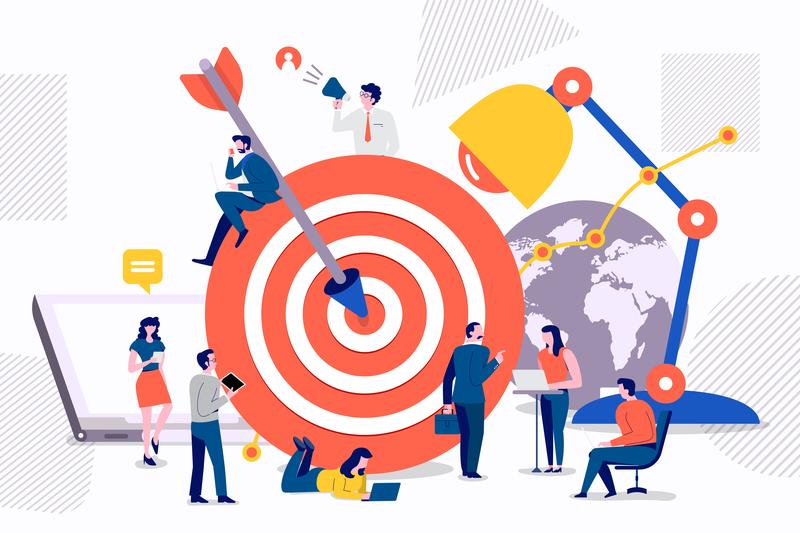Buyer personas: 8 steps to create them and how to use them in your Inbound Marketing strategy
Do not get stuck in traditional market segmentation, knowing the needs of your customers will multiply the results of your strategy

Many companies have a good budget, have a marketing team, and thrive in a high-demand niche. But they don’t have enough sales. This problem is very common and can be solved by creating Buyer Personas. In this article we are going to explain a little what they are and how to create them with Inbound Marketing. We will also analyze how to use them effectively in the content strategy and we will show with an example Buyer Persona, how to apply the theory.
What are Buyer Personas?
This analysis is done based on demographic data, which has worked for millions of businesses for ages. But the digital age changed the game.
Now we must consider other important factors to define the target customers, factors that also influence the purchase decision process. In general, we must investigate the needs, concerns, objectives and challenges of consumers.
This is how the Buyer Persona, in Inbound Marketing, becomes a representation of the potential customer, formed from real data and considering subjective elements such as purchase motivation.
Buyer persona vs target

When in Marketing we refer to target or target audience, we generally point to a group of consumers, defined by their age, economic status, profession and location. Data that shed light on the profile of our consumers.
Buyer Personas are a target, but delimited by a much more precise factor: need. Let’s go to the concrete, to simplify the explanation let’s use a comparative table
| Target | Buyer Persona |
| Segment the market based on demographics (age, location, occupation, and financial income) | Segment the market according to consumer needs |
| Focus the strategy to attract the target | Focus the strategy on solving needs |
| By focusing the strategy on the target, other sales opportunities are lost sight of | By focusing the strategy on solving needs, different types of public are attracted |
Knowing the needs of consumers is understanding the motivation of the target audience . And this is very important. Remember that Inbound Marketing is based on attracting sales opportunities through content production . Creating Buyer Personas is the key to defining what type of information our customers are looking for in each phase of the purchasing process.
So, if we have the motivation and we know the needs of the Buyer Persona, we can create content that brings us closer from the first moment and allows us to generate conversions.
Benefits of creating Buyer Personas in Inbound Marketing
✔ They help you create and develop a content strategy aimed at the right audience
✔ You can segment your database according to each Buyer Person and thus send personalized emails (which increases the opening rate)
✔ It allows you to plan conversion paths (content for each phase of the purchase process)
In figures: Why are Buyer Personas important in Inbound Marketing?
✔ Digital marketing is two to five times more effective than traditional marketing
✔ A content strategy oriented to Buyer Personas increases sales opportunities by 97%, appearance in organic Google searches by 55% and traffic to your website by 210%.
✔ According to Hubspot , the open rate increases by 14% when emails are created based on Buyer Personas
✔ Ads are twice as effective if targeting is done taking Buyer Personas into account
8 steps to create Buyer Personas in Inbound Marketing
Research: Gather information online about your potential customers. Interview your buyers. Collect demographic data and observe patterns of need. You need to know what they expect from your company.
Evaluate data from your website: Who visits you? Who frequently check your page? What do they all have in common? What is the difference between them? These are important data to define the Buyer Persona profile.
Personal and professional data: Now that you know your potential client, let’s name them. What do you think of Luis? Perfect. Now we need to define who Luis is, what he studied and what he does.
Demographic data: Proceed with traditional market segmentation, being very specific with the figures. Are you male or female? How old are you? Where do you live? What is your monthly income?
Behavior: To attract Luis, it is necessary to know what information channels he uses regularly. What social networks do you frequent? What kind of information do you look for on the internet? Do you use email?
Needs, objectives and challenges: These three factors are key for the Target to become a Buyer Persona. You need to know Luis’s needs, why does he need your product or service? What’s your problem? What concerns do you have? It’s also vital to consider your goals – what do you want to achieve? How do you hope to achieve it? And finally, what are your challenges: Do you have any obstacles? What do you not know?
What to do to help you: Can the company solve your problem? How can you do it? Answering these two questions will allow us to develop the appropriate content that will turn the Buyer Persona into a sales opportunity.
Concerns and objections: If you know Luis well, you can anticipate his possible concerns or objections. You must develop content that responds in advance to their concerns, so that they trust your brand.
How to create Buyer Personas if I don’t have customers yet
Market research in the Inbound Marketing style
Perform a classic segmentation and then investigate the behavior of that group of consumers. By conducting digital surveys, interviews and analyzing data from websites similar to yours, you will be able to identify the needs, concerns, challenges and objectives of your potential buyers. From there, you have all the elements to create your Buyer Persona.
Google Analitycs study
This very powerful tool from Google allows you to know where your traffic comes from, what devices your readers use, how many times they read you, how they found you and a lot of other data that is a reliable source to create a very accurate profile.
You only need to compare this data with the needs of the company and you will be able to define your ideal consumer.
17 questions to create your Buyer Persona
Labor questions
- Which is your charge?
- How is your performance measured?
- What knowledge or talent does your job require?
- Do you have a boss or do you manage staff?
About the company…
- In what industry does your company develop?
- How big is your company?
goals
- What are your responsibilities?
- What do you want to achieve?
Challenges
- Do you have challenges or obstacles to achieve your goals?
Information consumption habits
- Where do you look for information to learn about your work and what is happening in your industry?
- Do you read blogs, magazines or websites?
- What social networks do you frequent?
Personal information
- How old are you?
- What is his profession?
Shopping habits
- Do you contact your suppliers by email or phone?
- How do you search for suppliers? Do you use the internet for that task?
- Have you bought recently? What motivated you to make the purchase?
Buyer Persona example
Fictitious client: Lima insurance company
We apply the questionnaire to define the profile of the Buyer Persona example
Buyer Person: Private patient
- Name: Miguel Iglesias
- Age: 3 5 years
- Studies : Marketing Professional
- Position : Content Manager of a Marketing Agency
- Salary: He has a gross salary of S / 2000 per month
- Objectives : Look for health insurance, to get rid of long waiting lists in Social Security every time you need to consult a specialist.
- Challenges or obstacles: Find out which life insurance is best for you, taking into account your budget and define which company offers the best service.
- Information habits: Search for information on the internet, frequently use social networks
- Do you use email or phone ?: Both
Buyer Person example: Large families
- Name: Marta Sánchez
- Age: 45 years
- Studies : Bachelor
- Position : Secretary in a law firm
- Salary: He has a gross salary of S / 2500 per month
- Goals : Find health insurance that includes your three children and husband.
- Challenges or obstacles: Find out which life insurance is best for you, taking into account your budget and define which company offers the best service.
- Information habits: Search for information on the internet, frequently use social networks
- Do you use email or phone ?: Both
Buyer Persona example : Companies
- Name: Oscar Navarro
- Age: 50 years
- Studies : Engineer
- Position : CEO
- Salary: He has a gross salary of S / 40,000 per month
- Objectives : Oscar is the CEO of a structure and wants to take out group health insurance to improve the quality of life of his workers.
- Challenges or obstacles: Find out which insurer offers you administrative support and customer service. Know the advantages of the policies of each company and verify the details on compensation due to temporary disability of a worker or on the corresponding tax relief.
- Information habits: Search for information on the internet, frequently use social networks
- Do you use email or phone ?: Both




